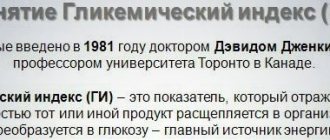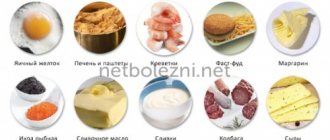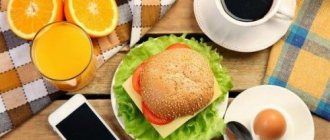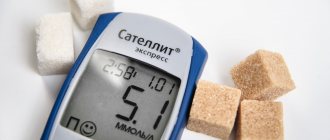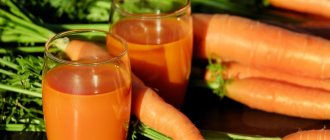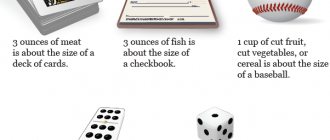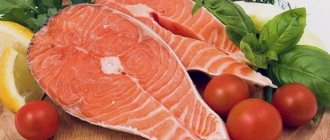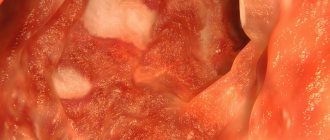General rules
The normal blood sugar level for healthy adults is 3.89 to 5.83 mmol/l. After meals, up to 7.8 mmol/l is allowed. Age must be taken into account, so in old age the norm is 4.6 to 6.4 mmol/l. Blood sugar is not a constant value and can change depending on diet, age, time of day, physical activity and stressful situations. To assess a person's health status, it is necessary to periodically examine it. An increase in level is not always regarded as diabetes mellitus .
If fasting levels are above 6.6 mmol/liter, prediabetes is diagnosed, which already indicates a metabolic failure. And people with risk factors (excess body weight, high blood pressure and cholesterol , hereditary predisposition, gestational diabetes during pregnancy ), starting from the age of 45, must be tested once a year. If the readings in the morning on an empty stomach (three times in a row) are 7.0 mmol/l or more, we can say about the development of diabetes mellitus . In this case, symptoms of diabetes mellitus may be observed: dry mouth, thirst, itching of the skin and external genitalia, frequent urination, feeling of hunger, metallic taste in the mouth.
In case of prediabetes, the patient is observed by a doctor, regularly monitors glucose and is required to follow a diet. In cases where it is not possible to normalize sugar levels with diet alone, additional antihyperglycemic agents are prescribed.
What diet is followed for high blood sugar and what is its purpose? Patients are prescribed treatment table No. 9 and its varieties. Its purpose is to normalize carbohydrate metabolism and prevent lipid metabolism disorders. In addition, with the help of therapeutic nutrition, you can determine endurance (tolerance) to carbohydrates - how much of them is absorbed from food.
A diet with high blood sugar has a moderately reduced energy value due to a significant reduction (or elimination) of easily digestible carbohydrates and fats. Sugar and sweets are excluded, the content of salt, extractives and cholesterol . The amount of proteins is normal. Options for therapeutic nutrition depend on the patient's weight, degree of hyperglycemia and concomitant diseases, and only a doctor can recommend them.
At normal weight, the calorie content of food should be 2300-2500 kcal, 90-100 g of protein, 75-80 g of fat and 300-350 g of carbohydrates. The doctor may recommend consuming this amount of carbohydrates, for example, 130 g with bread, and 170 g with vegetables and cereals.
If you are overweight, the calorie content is reduced to 1700 kcal. In this case, a person receives 110 g of protein, 80 g of fat and 120 g of carbohydrates.
Sources of easily digestible (simple) carbohydrates that should be excluded:
- sugar;
- jam;
- confectionery;
- syrups;
- sweet fruits and vegetables;
- White bread.
The following vegetables should be limited or excluded:
- potatoes, because they contain a lot of starch, which increases blood glucose;
- carrots are also a highly starchy root vegetable;
- tomatoes due to their high glucose content;
- beets ( glycemic index at the level of pasta and pancakes). Even with minimal consumption, there is a sharp jump in glucose levels.
Vegetables you should prefer:
- eggplants, which contain very little glucose;
- red salad pepper due to its high vitamin content. groups B , C ;
- pumpkin, which helps reduce glucose;
- zucchini and squash, which normalize carbohydrate metabolism.
It should be taken into account that heat treatment of vegetables leads to an increase in the glycemic index (GI), if it was initially low. Thus, stewed eggplants, cabbage, zucchini and tomatoes increase the sugar content. What fruits are best to eat? You need to choose those with a glycemic index of no more than 55. These are apricots, cherry plums, peaches, plums, apples, grapefruits, lingonberries, cranberries, gooseberries, cherries, sea buckthorn, red currants.
The glycemic index gives an idea of how quickly carbohydrates will be broken down into sugar and released into the bloodstream. When consuming foods with a high index, glucose levels increase significantly, which causes increased insulin , provoking a feeling of hunger and activating fat deposits. But even the “safest” fruit can become harmful if consumed in unlimited quantities. A serving of fruit should fit in your palm; one piece of watermelon or melon (200 grams) or one cup of berries is enough.
For many, giving up sugary foods makes life difficult. In this case, you can use a sugar substitute. Known natural ones are xylitol , maltitol , sorbitol and fructose . The most common synthetic ones are cyclamate , aspartame , saccharin , ultraslastin and sucrasite .
Fructose is naturally found in honey, fruits and berries. The largest amount is found in grapes, pears, apples, cherries and watermelon. The simple carbohydrates contained in it can increase sugar levels, but only slightly. Fructose is slowly absorbed by the intestines, but is quickly broken down, has a low calorie content and a low glycemic index , so it can be consumed even by people with diabetes, but in moderation. To process it, the body needs five times less insulin . It is twice as sweet as sugar, so you need to reduce the amount consumed compared to sugar (1 tsp per glass of tea). Available in powder of 250 and 500 g, sold in pharmacies.
Xylitol is obtained by processing plant raw materials (corn cobs); its sweetness is equivalent to ordinary sugar and does not have a special effect on glucose levels. The calorie content of 1 g is equal to 4 kcal. The daily dose is 30 g. The sugar substitute maltitol ( E95 ) is obtained from starch, corn or potatoes. Its glycemic index is 26 (half that of sugar) and the calorie content of 1 gram is 2.1 kcal. Maltitol syrup is added when preparing preserves and jams, in the confectionery industry (products for diabetics). consume no more than 90 g of mantitol
Sucralose is obtained from sugar by processing it, therefore reducing the adverse effects on glucose levels. This sugar substitute is recommended for overweight people, children and pregnant women. The same cannot be said about cyclamate ( E952 ), which is banned in the USA. Aspartame ( E951 is used in the production of sweet drinks . The daily dose of sucrasite is 0.7 grams, available in tablets. Ultraslastin combines cyclamate, saccharin, aspartame and acesulfame. If we talk about choosing one or another sugar substitute, then we should give preference to natural products, but they are higher in calories.
A diet without salt and sugar is not related to permanent therapeutic nutrition for diabetes mellitus and is used short-term (up to 15 days) for the purpose of intensive weight loss. With this therapeutic diet, the amount of salt is limited to 12 g per day, and with concomitant hypertension and nephropathy it is reduced to 2.8 g, but is not completely excluded.
Table No. 9
Table 9 is a specially designed diet for people with diabetes. This diet is rich in healthy and tasty dishes for diabetics. Its essence lies in the exclusion of foods with fast carbohydrates and moderate consumption of carbohydrates in general. Due to the slow increase in blood glucose levels, a person feels full for a long time. This also has a positive effect on the pancreas.
Every diabetic is required to familiarize himself with the principles and permitted foods of diet table No. 9
Dishes that may be included in the Breakfast diet:
- Fried eggs with pork breast.
- Omelet with vegetables, omelette with meat products (without processed foods), if desired, you can grate cheese into the omelette.
- Boiled eggs, low-fat yogurt, cod liver.
- Vegetable side dish, hazelnuts or almonds, black or green tea (not sweet).
Dinner:
- Pork (stewed) with herbs or cabbage.
- Baked chicken with vegetable side dish.
- Boiled meat with a salad of fresh vegetables.
- Boiled or baked fish.
- Pork thigh steak, fresh vegetables or salad.
- Homemade sausage with rye bread.
Diet variety depends entirely on your imagination and taste preferences.
Snack products:
- Almonds, hazelnuts or Brazil nuts.
- Boiled eggs.
- Baked boiled pork.
- Hard cheese.
- Avocado (quite expensive, but healthy product).
If it's time for a snack and you don't have anything on hand, you can eat raw eggs, which can be purchased at the store.
IMPORTANT! People diagnosed with type 1 and type 2 diabetes should keep a food diary.
The principles of this diet:
- fragmentation and regularity of food intake;
- each portion of food should be the same in volume and calorie content;
- permissible ratio of fats and carbohydrates;
- sufficient intake of vitamins and microelements by the body;
- mainly boiled, stewed or baked food.
Products and dishes excluded from the diet:
- smoked, spicy and fried foods;
- sugar and sugar-containing products;
- thick broths and soups;
- fermented milk products (fat);
- alcohol.
By following the prescribed diet, you significantly simplify and prolong your life.
Authorized Products
A diet to lower blood sugar involves reducing bread consumption to 300 g per day. Preference should be given to rye, wheat from second grade flour, protein-bran and protein-wheat.
A balanced diet includes many vegetables that can be used raw, stewed and boiled as side dishes, casseroles and added to vegetarian soups. Vegetables containing up to 5% carbohydrates are preferred (pumpkin, zucchini, cucumbers, lettuce, cabbage, squash, eggplant). Potatoes are allowed with restrictions taking into account the carbohydrate norm for each patient individually. High-carbohydrate foods also include: carrots, green peas, and beets. You can eat vegetable caviar and seaweed. The first courses are prepared in a weak broth with vegetables. Borscht, cabbage soup, beetroot soup, okroshka, mushroom soup and soups with meatballs - with permitted cereals and potatoes (limited).
It is allowed to eat lean meats, chicken, and turkey. Meat dishes are prepared boiled, baked and fried. The same requirements apply to fish. The amount of cereal is limited to the limits of carbohydrate norms for each patient - these are buckwheat, barley, pearl barley, millet and oatmeal; legumes are allowed (lentils are preferred).
Fermented milk drinks (kefir, yogurt, matsoni) should be present in the diet daily. Milk, semi-fat cottage cheese and dishes made from it. Mild cheese in small quantities and sour cream (only in dishes). Eggs can be consumed one per day (whole) soft-boiled and prepared in the form of protein omelettes. Butter and all kinds of vegetable oils are added to prepared dishes. Drinks you can drink include tea with sweetener, coffee with milk, vegetable juices, unsweetened fruit juices, and rosehip decoction.
Sweet and sour berries and fruits in any form are allowed: fresh, jelly, compotes, mousses. How can you replace sugar in desserts and drinks? Xylitol, sorbitol and fructose. Xylitol no more than 30 g per day, fructose 1 tsp. three times a day with drinks. Honey is allowed in the amount of 1 tsp. 2-3 times a day. Products with sugar substitutes are allowed: candies, waffles, cookies. However, in this case, you need to know the norm - 1-2 candies three times a week.
Table of permitted products
| Proteins, g | Fats, g | Carbohydrates, g | Calories, kcal | |
Vegetables and greens | ||||
| zucchini | 0,6 | 0,3 | 4,6 | 24 |
| cabbage | 1,8 | 0,1 | 4,7 | 27 |
| sauerkraut | 1,8 | 0,1 | 4,4 | 19 |
| cauliflower | 2,5 | 0,3 | 5,4 | 30 |
| cucumbers | 0,8 | 0,1 | 2,8 | 15 |
| radish | 1,2 | 0,1 | 3,4 | 19 |
| tomatoes | 0,6 | 0,2 | 4,2 | 20 |
| pumpkin | 1,3 | 0,3 | 7,7 | 28 |
Fruits | ||||
| apricots | 0,9 | 0,1 | 10,8 | 41 |
| watermelon | 0,6 | 0,1 | 5,8 | 25 |
| cherry | 0,8 | 0,5 | 11,3 | 52 |
| pears | 0,4 | 0,3 | 10,9 | 42 |
| nectarine | 0,9 | 0,2 | 11,8 | 48 |
| peaches | 0,9 | 0,1 | 11,3 | 46 |
| plums | 0,8 | 0,3 | 9,6 | 42 |
| apples | 0,4 | 0,4 | 9,8 | 47 |
Berries | ||||
| cowberry | 0,7 | 0,5 | 9,6 | 43 |
| blackberry | 2,0 | 0,0 | 6,4 | 31 |
| raspberries | 0,8 | 0,5 | 8,3 | 46 |
| currant | 1,0 | 0,4 | 7,5 | 43 |
Cereals and porridges | ||||
| buckwheat (kernel) | 12,6 | 3,3 | 62,1 | 313 |
| oat groats | 12,3 | 6,1 | 59,5 | 342 |
| corn grits | 8,3 | 1,2 | 75,0 | 337 |
| pearl barley | 9,3 | 1,1 | 73,7 | 320 |
| millet cereal | 11,5 | 3,3 | 69,3 | 348 |
| barley grits | 10,4 | 1,3 | 66,3 | 324 |
Bakery products | ||||
| Rye bread | 6,6 | 1,2 | 34,2 | 165 |
| bran bread | 7,5 | 1,3 | 45,2 | 227 |
| doctor's bread | 8,2 | 2,6 | 46,3 | 242 |
| whole grain bread | 10,1 | 2,3 | 57,1 | 295 |
Confectionery | ||||
| diabetic crackers | 10,5 | 5,7 | 73,1 | 388 |
Raw materials and seasonings | ||||
| xylitol | 0,0 | 0,0 | 97,9 | 367 |
| honey | 0,8 | 0,0 | 81,5 | 329 |
| fructose | 0,0 | 0,0 | 99,8 | 399 |
Dairy | ||||
| milk | 3,2 | 3,6 | 4,8 | 64 |
| kefir | 3,4 | 2,0 | 4,7 | 51 |
| sour cream 15% (low fat) | 2,6 | 15,0 | 3,0 | 158 |
| curdled milk | 2,9 | 2,5 | 4,1 | 53 |
| acidophilus | 2,8 | 3,2 | 3,8 | 57 |
| yogurt | 4,3 | 2,0 | 6,2 | 60 |
Cheeses and cottage cheese | ||||
| cottage cheese 0.6% (low fat) | 18,0 | 0,6 | 1,8 | 88 |
| cottage cheese 1.8% (low-fat) | 18,0 | 1,8 | 3,3 | 101 |
| cottage cheese 5% | 17,2 | 5,0 | 1,8 | 121 |
Meat products | ||||
| beef | 18,9 | 19,4 | 0,0 | 187 |
| beef tongue | 13,6 | 12,1 | 0,0 | 163 |
| veal | 19,7 | 1,2 | 0,0 | 90 |
| rabbit | 21,0 | 8,0 | 0,0 | 156 |
Bird | ||||
| chicken | 16,0 | 14,0 | 0,0 | 190 |
| turkey | 19,2 | 0,7 | 0,0 | 84 |
Eggs | ||||
| chicken eggs | 12,7 | 10,9 | 0,7 | 157 |
Fish and seafood | ||||
| herring | 16,3 | 10,7 | — | 161 |
Oils and fats | ||||
| butter | 0,5 | 82,5 | 0,8 | 748 |
| corn oil | 0,0 | 99,9 | 0,0 | 899 |
| olive oil | 0,0 | 99,8 | 0,0 | 898 |
| sunflower oil | 0,0 | 99,9 | 0,0 | 899 |
| ghee | 0,2 | 99,0 | 0,0 | 892 |
Non-alcoholic drinks | ||||
| mineral water | 0,0 | 0,0 | 0,0 | — |
| coffee | 0,2 | 0,0 | 0,3 | 2 |
| instant chicory | 0,1 | 0,0 | 2,8 | 11 |
| black tea without sugar | 0,1 | 0,0 | 0,0 | — |
Juices and compotes | ||||
| carrot juice | 1,1 | 0,1 | 6,4 | 28 |
| plum juice | 0,8 | 0,0 | 9,6 | 39 |
| tomato juice | 1,1 | 0,2 | 3,8 | 21 |
| pumpkin juice | 0,0 | 0,0 | 9,0 | 38 |
| rose hip juice | 0,1 | 0,0 | 17,6 | 70 |
| Apple juice | 0,4 | 0,4 | 9,8 | 42 |
| * data is per 100 g of product | ||||
Fully or partially limited products
The following are completely excluded from the diet: baked goods made from butter and puff pastry, curd mass, sweet desserts and ice cream, rice, semolina and pasta, as well as milk soups with these cereals. You should not consume sweet juices (grape, apricot, pear), sugar-filled lemonades, preserves and jams.
Not only foods rich in carbohydrates are prohibited, but also fatty ones: fatty broths, duck meat, goose, pork, smoked meats, sausages, fatty fish, canned food with butter, fatty and hot cream sauces.
It is advisable to prepare dishes without salt and sugar and exclude salted cheeses and pickled vegetables. Liver and dishes made from it, egg yolks, honey and spices (pepper, horseradish, mustard) are allowed in limited quantities.
Table of prohibited products
| Proteins, g | Fats, g | Carbohydrates, g | Calories, kcal | |
Vegetables and greens | ||||
| carrot | 1,3 | 0,1 | 6,9 | 32 |
| beet | 1,5 | 0,1 | 8,8 | 40 |
| horseradish | 3,2 | 0,4 | 10,5 | 56 |
Fruits | ||||
| apricots | 0,9 | 0,1 | 10,8 | 41 |
| pineapples | 0,4 | 0,2 | 10,6 | 49 |
| bananas | 1,5 | 0,2 | 21,8 | 95 |
| melon | 0,6 | 0,3 | 7,4 | 33 |
| mango | 0,5 | 0,3 | 11,5 | 67 |
Berries | ||||
| grape | 0,6 | 0,2 | 16,8 | 65 |
Nuts and dried fruits | ||||
| raisin | 2,9 | 0,6 | 66,0 | 264 |
| dried figs | 3,1 | 0,8 | 57,9 | 257 |
| dates | 2,5 | 0,5 | 69,2 | 274 |
Cereals and porridges | ||||
| semolina | 10,3 | 1,0 | 73,3 | 328 |
| rice | 6,7 | 0,7 | 78,9 | 344 |
| sago | 1,0 | 0,7 | 85,0 | 350 |
Flour and pasta | ||||
| pasta | 10,4 | 1,1 | 69,7 | 337 |
| noodles | 12,0 | 3,7 | 60,1 | 322 |
Bakery products | ||||
| wheat bread | 8,1 | 1,0 | 48,8 | 242 |
Confectionery | ||||
| jam | 0,3 | 0,2 | 63,0 | 263 |
| candies | 4,3 | 19,8 | 67,5 | 453 |
| pastry cream | 0,2 | 26,0 | 16,5 | 300 |
Ice cream | ||||
| ice cream | 3,7 | 6,9 | 22,1 | 189 |
Chocolate | ||||
| chocolate | 5,4 | 35,3 | 56,5 | 544 |
Raw materials and seasonings | ||||
| mustard | 5,7 | 6,4 | 22,0 | 162 |
| mayonnaise | 2,4 | 67,0 | 3,9 | 627 |
| sugar | 0,0 | 0,0 | 99,7 | 398 |
Dairy | ||||
| cream | 2,8 | 20,0 | 3,7 | 205 |
| sour cream 25% (classic) | 2,6 | 25,0 | 2,5 | 248 |
| sour cream 30% | 2,4 | 30,0 | 3,1 | 294 |
Cheeses and cottage cheese | ||||
| glazed cheese | 8,5 | 27,8 | 32,0 | 407 |
| curd | 7,1 | 23,0 | 27,5 | 341 |
Meat products | ||||
| pork | 16,0 | 21,6 | 0,0 | 259 |
| salo | 2,4 | 89,0 | 0,0 | 797 |
Bird | ||||
| smoked chicken | 27,5 | 8,2 | 0,0 | 184 |
| duck | 16,5 | 61,2 | 0,0 | 346 |
| smoked duck | 19,0 | 28,4 | 0,0 | 337 |
| goose | 16,1 | 33,3 | 0,0 | 364 |
Fish and seafood | ||||
| smoked fish | 26,8 | 9,9 | 0,0 | 196 |
| canned fish | 17,5 | 2,0 | 0,0 | 88 |
| sardine in oil | 24,1 | 13,9 | — | 221 |
| cod (liver in oil) | 4,2 | 65,7 | 1,2 | 613 |
Oils and fats | ||||
| animal fat | 0,0 | 99,7 | 0,0 | 897 |
| cooking fat | 0,0 | 99,7 | 0,0 | 897 |
Non-alcoholic drinks | ||||
| lemonade | 0,0 | 0,0 | 6,4 | 26 |
| Pepsi | 0,0 | 0,0 | 8,7 | 38 |
| Fanta | 0,0 | 0,0 | 11,7 | 48 |
Juices and compotes | ||||
| apricot juice | 0,9 | 0,1 | 9,0 | 38 |
| grape juice | 0,3 | 0,0 | 14,0 | 54 |
| * data is per 100 g of product | ||||
What you need to give up
The development of a dietary diet is based on medical diet No. 9. According to Pevzner's classification, the ninth table is recommended for patients with diabetes. There are a number of foods and dishes that increase blood sugar.
To bring the glucose level to normal levels, the following are eliminated from the menu:
- Soups made with broth from pork, chicken with skin, and duck. Milk soups based on fat milk.
- Pork meat dishes, stews, as well as sausages and pates.
- Fish prepared by smoking, salting, and preservation.
- Dairy products with a high percentage of fat (sour cream more than 10%, cheese more than 45%, homemade cottage cheese, curd mass and glazed cheese curds).
- Ready-made packaged juices, sweet cocktails (regardless of the base), bottled tea.
- Baking and confectionery (cakes, ice cream, pastries and other desserts).
- Dishes classified as fast food and fatty sauces based on mayonnaise.
Prohibited foods, according to their high glycemic index, are presented in the table.
In order not to provoke “jumps” in sugar, you should not eat dishes and foods with a GI of more than 70 units
Menu (Power Mode)
Meals with high sugar levels should be 5-6 times a day and the main condition is an even distribution of carbohydrates. Knowing the approximate set of products, you can create a menu. In each specific case, the number of products changes and is specified by the doctor.
The set of products for the day looks like this:
- butter 10 g, vegetable oil 20 g;
- meat and fish 100 g each;
- cottage cheese 50 g;
- milk 200 ml;
- yogurt 200 ml;
- sour cream 20 g;
- oatmeal (buckwheat) 50 g;
- carrots 75 g;
- tomatoes 20 g;
- potatoes 200 g;
- apples 200 g;
- cabbage 250 g;
- rye bread 200 g.
First day
| Breakfast |
|
| Lunch |
|
| Dinner |
|
| Afternoon snack |
|
| Dinner |
|
| For the night |
|
Second day
| Breakfast |
|
| Lunch |
|
| Dinner |
|
| Afternoon snack |
|
| Dinner |
|
| For the night |
|
The third day
| Breakfast |
|
| Lunch |
|
| Dinner |
|
| Afternoon snack |
|
| Dinner |
|
| For the night |
|
Dietary nutrition for type 2 diabetes
Type 2 diabetes mellitus occurs due to excess weight. The body continues to produce insulin, but it is not active. Patients with this diagnosis can live for decades. It is very important to monitor your diet, load your body with physical activity and bring your weight to the required level. Meals are strictly fractional, intervals should not exceed 2–3 hours.
Sample menu for a day for type 2 diabetes:
Nutrition for diabetics
- 7:00 – breakfast: oatmeal with milk 200 g;
- 9:30 – lunch: boiled egg 1–2 pcs.;
- 13:00 – lunch: vegetable borscht – 200 g, roast of permitted meat – 70 g, 100 g of fresh vegetables, compote or natural juice from dried fruits – 200 ml, whole grain bread – 50 g;
- 16:00 – afternoon snack: 150 g cottage cheese casserole;
- 18:00 – dinner: baked or stewed fish with vegetables – 200 g;
- 21:00 – if you feel hungry, you are allowed to drink 250 ml of kefir.
Reviews and results
A sugar-lowering diet does not replace a varied diet. It is important to choose foods with a low glycemic index and keep track of what you eat. You should not self-medicate and prescribe medical nutrition yourself. Only regular examination by a doctor and strict adherence to his recommendations will help you effectively maintain your sugar level. Everyone evaluates the effectiveness of this therapeutic nutrition positively.
- “... I have been suffering from diabetes since I was 30 years old, and in my youth I didn’t pay much attention to nutrition - I often broke my diet and there were sugar spikes. I can say that dietary nutrition is simply necessary. It helps a lot not only in terms of health, but also in maintaining normal weight. If I gain weight, the doctor prescribes a more strict diet for several months - the amount of bread and cereals is significantly reduced";
- “... They prescribed this diet for high sugar initially for 3 weeks, and during this time she regularly took tests. Since my sugar is not very high and I strictly monitored my diet, the doctor did not prescribe medications. This is confirmation that nutritional therapy really does help, and I have been controlling my sugar this way for many years. For now this is the case, but as you get older you may have to take pills”;
- “... I’ve been eating this way for a long time because I suffer from diabetes. Since I take pills, the doctor allowed me to expand my diet a little (a little more bread and cereal, more fruits and berries in the summer). In general, I have adapted - I analyze the quantity and quality of food eaten and blood sugar tests and draw conclusions”;
- “... On this diet, sugar is restored in ten days - tested on myself. But if you move away from your diet and allow yourself illicit foods, everything will come to naught. You need to have willpower to keep your blood tests normal without taking pills and just eating. It's difficult, but you have to try. I think pills are for the lazy.”
Eggplants for diabetes
One of the main advantages of eggplants is their low GI (glycemic index), they consist of 90% water. The fruit is rich in beneficial vitamins, microelements and dietary fiber, promotes the production of insulin, which has a positive effect on the patient’s pancreas. Reduces the concentration of glucose in the body, improves water-salt balance, strengthens the walls of blood vessels. It has a positive effect on the psychological and physical state of a diabetic, the person becomes less irritable.
Eggplants are very useful in the fight against diabetes, in addition, they can be very tasty to cook
There are many recipes for delicious eggplant preparation. To improve the health of the body, it is not necessary to consume them every day; 2 times a week is quite enough. It is worth choosing eggplants with thin skin and fewer seeds. It is not recommended to fry them; boiled, stewed or baked eggplants will be much healthier.
